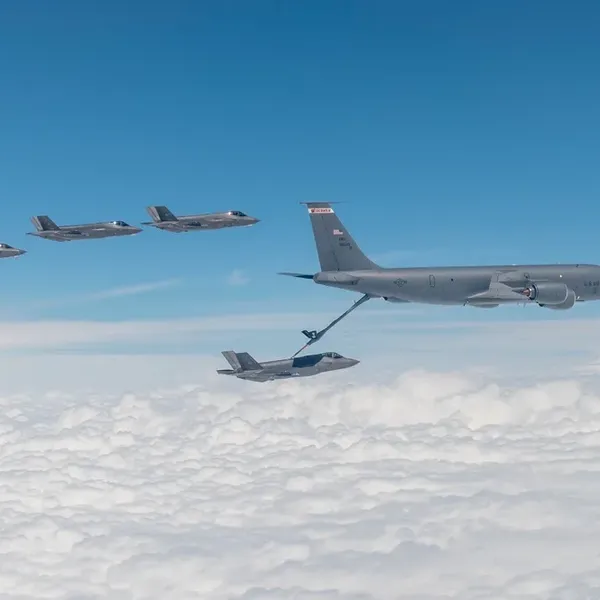
An F-15E Strike Eagle from Bagram Air Base deploys flares over Afghanistan Nov. 12, 2008. (Photo: U.S. Air Force/Staff Sgt. Aaron Allmon)
Pentagon: American Public Doesn't Need to Know How Much Territory We've Lost in Afghanistan
"The only people who don't know what's going on are the people who are paying for all of this, and that's the American taxpayer."
The Pentagon will no longer inform the American public who has greater control of Afghan districts--the Afghan government or insurgents--the latest sign that the military is trying to obfuscate the failure of its 18-year war in Afghanistan
The revelation comes from the Special Inspector General for Afghanistan Reconstruction's (SIGAR) quarterly report (pdf).
Per the report:
This quarter, the U.S.-commanded NATO Resolute Support (RS) mission in Afghanistan formally notfied SIGAR that it is no longer assessing district-level insurgent or government control or influence. The RS mission said the district-level stability assessments were "of limited decision-making value to the [RS] Commander." RS added that there is currently no other product or forum through which district-level control data is communicated to the command. The last district-stability data RS produced was for its October 22, 2018, assessment; SIGAR reported on that assessment in its January 2019 Quarterly Report to the United States Congress.
John Sopko, the special inspector general, told reporters last week that he thought the decision by the Pentagon doesn't make sense:
The Afghan people know which districts are controlled by the Taliban. The Taliban obviously know which districts they control. Our military knows it. Everybody in Afghanistan knows it. The only people who don't know what's going on are the people who are paying for all of this, and that's the American taxpayer.
The new data on the matter would likely not have been anything for the Pentagon to brag about.
"As of October 22, 2018, #Afghan government control or influence over its districts at lowest level reported since #SIGAR began receiving district control data in November 201," SIGAR said in a tweet Tuesday.
SIGAR linked to its previous quarterly report, which showed that in October 2018, the Afghan government exercised control of 64 percent of the population compared to 69 percent in August of 2016. Insurgents controlled 11 percent in October 2018, an increase from the nine percent it controlled in August 2016.
In terms of district control or influence, the Afghan government claimed 54 percent in October 2018, but that figure dropped to 72 percent in November 2015. Insurgents claimed control of 12 percent of districts in October 2018--an increase from the seven percent it had in November 2015.
This issue is not the only measure of the Afghan war being blocked from public view. From the SIGAR report:
USFOR-A continued to classify or restrict from public release, in accordance with classification guidelines or other restrictions placed by the Afghan government, the following data (mostly since October 2017):
- ANDSF [Afghan National Defense and Security Forces ] casualties, by force element and total;
- Corps- and zone-level Afghan National Army (ANA) and Afghan National Police (ANP) authorized and assigned strength by component;
- Performance assessments for the ANA, ANP, MOD, and MOI;
- Information about the operational readiness of ANA and ANP equipment;
- Special Mission Wing (SMW) information, including the number and type of airframes in the SMW inventory, the number of pilots and aircrew, and the operational readiness (and associated benchmarks) of SMW airframe;
- Reporting on anticorruption efforts by the MOI (unclassifed but not publicly releasable);
- Reporting on the status of the ANDSF's progress on security-related benchmarks of the Afghanistan Compact (unclassifed but not publicly releasable).
"What we are finding is now almost every metric for success or failure is now classified or non-existent," said Sopko.
SIGAR's report to Congress comes on the heels of a the United Nations report showing that U.S.-backed forces killed more Afghan civilians than the Taliban and other armed anti-government groups did in the first three months of 2019. And in 2018, the U.N. recently reported, Afghan civilian deaths hit a new high since records began a decade ago.
The Cost of War project estimates that the war in Afghanistan has directly caused at least 147,000 deaths, over 38,000 of whom were civilians.
An Urgent Message From Our Co-Founder
Dear Common Dreams reader, The U.S. is on a fast track to authoritarianism like nothing I've ever seen. Meanwhile, corporate news outlets are utterly capitulating to Trump, twisting their coverage to avoid drawing his ire while lining up to stuff cash in his pockets. That's why I believe that Common Dreams is doing the best and most consequential reporting that we've ever done. Our small but mighty team is a progressive reporting powerhouse, covering the news every day that the corporate media never will. Our mission has always been simple: To inform. To inspire. And to ignite change for the common good. Now here's the key piece that I want all our readers to understand: None of this would be possible without your financial support. That's not just some fundraising cliche. It's the absolute and literal truth. We don't accept corporate advertising and never will. We don't have a paywall because we don't think people should be blocked from critical news based on their ability to pay. Everything we do is funded by the donations of readers like you. Will you donate now to help power the nonprofit, independent reporting of Common Dreams? Thank you for being a vital member of our community. Together, we can keep independent journalism alive when it’s needed most. - Craig Brown, Co-founder |
The Pentagon will no longer inform the American public who has greater control of Afghan districts--the Afghan government or insurgents--the latest sign that the military is trying to obfuscate the failure of its 18-year war in Afghanistan
The revelation comes from the Special Inspector General for Afghanistan Reconstruction's (SIGAR) quarterly report (pdf).
Per the report:
This quarter, the U.S.-commanded NATO Resolute Support (RS) mission in Afghanistan formally notfied SIGAR that it is no longer assessing district-level insurgent or government control or influence. The RS mission said the district-level stability assessments were "of limited decision-making value to the [RS] Commander." RS added that there is currently no other product or forum through which district-level control data is communicated to the command. The last district-stability data RS produced was for its October 22, 2018, assessment; SIGAR reported on that assessment in its January 2019 Quarterly Report to the United States Congress.
John Sopko, the special inspector general, told reporters last week that he thought the decision by the Pentagon doesn't make sense:
The Afghan people know which districts are controlled by the Taliban. The Taliban obviously know which districts they control. Our military knows it. Everybody in Afghanistan knows it. The only people who don't know what's going on are the people who are paying for all of this, and that's the American taxpayer.
The new data on the matter would likely not have been anything for the Pentagon to brag about.
"As of October 22, 2018, #Afghan government control or influence over its districts at lowest level reported since #SIGAR began receiving district control data in November 201," SIGAR said in a tweet Tuesday.
SIGAR linked to its previous quarterly report, which showed that in October 2018, the Afghan government exercised control of 64 percent of the population compared to 69 percent in August of 2016. Insurgents controlled 11 percent in October 2018, an increase from the nine percent it controlled in August 2016.
In terms of district control or influence, the Afghan government claimed 54 percent in October 2018, but that figure dropped to 72 percent in November 2015. Insurgents claimed control of 12 percent of districts in October 2018--an increase from the seven percent it had in November 2015.
This issue is not the only measure of the Afghan war being blocked from public view. From the SIGAR report:
USFOR-A continued to classify or restrict from public release, in accordance with classification guidelines or other restrictions placed by the Afghan government, the following data (mostly since October 2017):
- ANDSF [Afghan National Defense and Security Forces ] casualties, by force element and total;
- Corps- and zone-level Afghan National Army (ANA) and Afghan National Police (ANP) authorized and assigned strength by component;
- Performance assessments for the ANA, ANP, MOD, and MOI;
- Information about the operational readiness of ANA and ANP equipment;
- Special Mission Wing (SMW) information, including the number and type of airframes in the SMW inventory, the number of pilots and aircrew, and the operational readiness (and associated benchmarks) of SMW airframe;
- Reporting on anticorruption efforts by the MOI (unclassifed but not publicly releasable);
- Reporting on the status of the ANDSF's progress on security-related benchmarks of the Afghanistan Compact (unclassifed but not publicly releasable).
"What we are finding is now almost every metric for success or failure is now classified or non-existent," said Sopko.
SIGAR's report to Congress comes on the heels of a the United Nations report showing that U.S.-backed forces killed more Afghan civilians than the Taliban and other armed anti-government groups did in the first three months of 2019. And in 2018, the U.N. recently reported, Afghan civilian deaths hit a new high since records began a decade ago.
The Cost of War project estimates that the war in Afghanistan has directly caused at least 147,000 deaths, over 38,000 of whom were civilians.
The Pentagon will no longer inform the American public who has greater control of Afghan districts--the Afghan government or insurgents--the latest sign that the military is trying to obfuscate the failure of its 18-year war in Afghanistan
The revelation comes from the Special Inspector General for Afghanistan Reconstruction's (SIGAR) quarterly report (pdf).
Per the report:
This quarter, the U.S.-commanded NATO Resolute Support (RS) mission in Afghanistan formally notfied SIGAR that it is no longer assessing district-level insurgent or government control or influence. The RS mission said the district-level stability assessments were "of limited decision-making value to the [RS] Commander." RS added that there is currently no other product or forum through which district-level control data is communicated to the command. The last district-stability data RS produced was for its October 22, 2018, assessment; SIGAR reported on that assessment in its January 2019 Quarterly Report to the United States Congress.
John Sopko, the special inspector general, told reporters last week that he thought the decision by the Pentagon doesn't make sense:
The Afghan people know which districts are controlled by the Taliban. The Taliban obviously know which districts they control. Our military knows it. Everybody in Afghanistan knows it. The only people who don't know what's going on are the people who are paying for all of this, and that's the American taxpayer.
The new data on the matter would likely not have been anything for the Pentagon to brag about.
"As of October 22, 2018, #Afghan government control or influence over its districts at lowest level reported since #SIGAR began receiving district control data in November 201," SIGAR said in a tweet Tuesday.
SIGAR linked to its previous quarterly report, which showed that in October 2018, the Afghan government exercised control of 64 percent of the population compared to 69 percent in August of 2016. Insurgents controlled 11 percent in October 2018, an increase from the nine percent it controlled in August 2016.
In terms of district control or influence, the Afghan government claimed 54 percent in October 2018, but that figure dropped to 72 percent in November 2015. Insurgents claimed control of 12 percent of districts in October 2018--an increase from the seven percent it had in November 2015.
This issue is not the only measure of the Afghan war being blocked from public view. From the SIGAR report:
USFOR-A continued to classify or restrict from public release, in accordance with classification guidelines or other restrictions placed by the Afghan government, the following data (mostly since October 2017):
- ANDSF [Afghan National Defense and Security Forces ] casualties, by force element and total;
- Corps- and zone-level Afghan National Army (ANA) and Afghan National Police (ANP) authorized and assigned strength by component;
- Performance assessments for the ANA, ANP, MOD, and MOI;
- Information about the operational readiness of ANA and ANP equipment;
- Special Mission Wing (SMW) information, including the number and type of airframes in the SMW inventory, the number of pilots and aircrew, and the operational readiness (and associated benchmarks) of SMW airframe;
- Reporting on anticorruption efforts by the MOI (unclassifed but not publicly releasable);
- Reporting on the status of the ANDSF's progress on security-related benchmarks of the Afghanistan Compact (unclassifed but not publicly releasable).
"What we are finding is now almost every metric for success or failure is now classified or non-existent," said Sopko.
SIGAR's report to Congress comes on the heels of a the United Nations report showing that U.S.-backed forces killed more Afghan civilians than the Taliban and other armed anti-government groups did in the first three months of 2019. And in 2018, the U.N. recently reported, Afghan civilian deaths hit a new high since records began a decade ago.
The Cost of War project estimates that the war in Afghanistan has directly caused at least 147,000 deaths, over 38,000 of whom were civilians.

